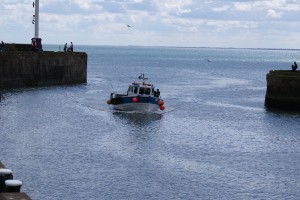What does it feel like to be flooded?
The media monitoring project at the Migration Observatory has analysed thousands of UK news articles on migration from the last few years, showing which words are most often associated with migrants – and the same finding was repeated more recently specifically for Romanians and Bulgarians arriving in 2014. One finding was how often, across both tabloids and broadsheets, words suggesting water were used as a metaphor for migration, such as flood, influx and wave. In one recent example, Michael Fallon, a Conservative minister, echoing Margaret Thatcher in the 1970s, described “whole towns and communities” in the UK “being swamped by huge numbers of migrants.”
Fallon particularly mentioned England’s East Coast, and his comment was made as two coastal constituencies switched their votes to the anti-immigrant UKIP. It is interesting that it is in coastal areas where anti-migrant sentiment – the feeling of being swamped and flooded by migrants – is strongest. Oddly, though, these coastal areas typically have some of the lowest numbers of migrants in the UK.
Many of these coastal areas, however, face a very different and very real flooding risk. Research shows that our coastal areas are vulnerable to climate change because of rising sea levels and wave heights and accelerated coastal erosion. The deprived and “left behind” seaside communities which UKIP is targeting may be especially vulnerable because of their reliance on the coastline for economic and social activities, because of ageing populations, deprivation and isolation, which negatively impact on resilience and hamper adaptation.
These issues are hard to think about; many of us tend to bury our heads in the sand rather than face up to the enormity of the challenge of climate change. Perhaps thinking about immigrants is easier.
But for many communities globally, the flooding has already long begun.
The photographer Alessandro Grassani, in his work Environmental Migrants: The Last Illusion, has produced extraordinary images of Bangladesh, which give some hint of an idea of what it might be like to be flooded: to live life knee-deep in water, to earn your livelihood beneath the rising sea level, to have the waves literally at your door.
Climate change and migration: how are they linked?
Grassani’s work has been supported by the International Organisation on Migration, the IOM, and his photographs were used to illustrate a presentation by IOM’s Dina Ionesco at our last COMPAS Breakfast Briefing.
Dina, a Policy Officer on the Migration, Environment and Climate Change programme at IOM, spoke alongside Alex Randall, the coordinator of the UK Climate Change and Migration Coalition (UKCCMC), on Climate change and migration: how are they linked?
The key issues
Dina presented a series of key issues relating the migration/climate change nexus. First, climate migration is highly complex, multi-factor phenomenon. Many of the classical categories and dichotomies in migration studies are challenged by it: is it temporary or permanent? Is it forced or voluntary? Climate change cannot be isolated from other patterns of global mobility, from other shifts and shocks in the world map. We lack the right legal, policy and academic terminologies for addressing climate migration.
An enormous range of predictions have been made about the possible impacts. (See Allan Findlay’s Breakfast Briefing and blogpost on this question and what it means for the UK.) The sheer volume of predictions – the uncertainty involved – is not always helpful for clear messages to the public or policy-makers. Media representation and policy discourse prefer victims or heroes of development and solid headline numbers, which are not forthcoming in this field.
Trends in research and narrative
Alex’s presentation took up these issues in outline key changing trends in how the field is conceptualised. The research is getting more complex, away from apocalyptic scenarios to more multi-faceted picture. There is no single group of "climate migrants". Instead, we have a multiplicity of stories.
There has been a shift away from climate migration framed as a security issue, to framing in terms of adaptation and creativity. There is no evidence, Alex argued, for climate migration creating significant security risks. Although it is important not to lose sight of the reality of forced migration due to climate change for some, agency, adaptation, incremental solutions and short-distance migration are more significant parts of the picture.
The policy challenge
 For the migration sector, this picture creates a series of challenges but also opportunities, which Dina outlined. The first is how to bring knowledge to bear on policy-making in such a complex field. When it is hard to reduce the story to simple facts and firm predictions, it is hard to generate adequate policy debate.
For the migration sector, this picture creates a series of challenges but also opportunities, which Dina outlined. The first is how to bring knowledge to bear on policy-making in such a complex field. When it is hard to reduce the story to simple facts and firm predictions, it is hard to generate adequate policy debate.
The migration sector and the environmental sector, and the related policy communities around these, remain remote from each other. There is an urgent need, Dina suggested, to do more work at the nexus between them, to create platforms for learning across: to insert climate issues into the migration debate and vice versa.
And because the phenomenon is complex, the policy challenge is multi-level. States are key players, but other actors are important too, both at supra- and sub-national level. These actors, Dina argued, need concrete support.
However, despite the complexity, the IOM’s work shows that there are positive stories of adaptation and resilience – but, Dina argued, these need to be more widely disseminated. As Alex concluded, one big global treaty won’t solve this problem; we need a series of small steps: regional co-operation, bi-lateral work between neighbouring states, bottom-up work with the most affected communities.
You can read the briefing document here, and listen to the podcast here.
We are grateful to the London office of the IOM, and especially Jenniffer Dew, for supporting this Breakfast Briefing. Read their report here.
Further reading:
- Trapped Populations – Hostages of Climate Change and other stories
- Moving Stories report: The voices of people who move in the context of environmental
- IOM Climate Change Key Messages for the COP
- IOM Infosheet: Perspectives on Migration, Environment and Climate Change
- IOM Outlook on Migration, Environment and Climate Change

